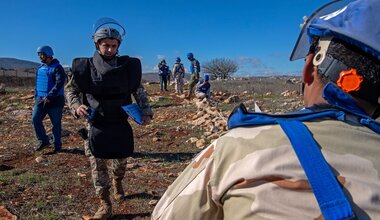Deployment of Lebanese Armed Forces regiment helps maintain stability in south Lebanon
In a military command post tucked in the hill of Kafr Dunin, about 670 metres from the sea level in south Lebanon, Brigadier General Ramez al-Khamis watches as dozens of his troops get ready for a drill. A military commander signals “start” and the soldiers set out for a simulated mission.
These soldiers are members of the recently deployed rapid intervention regiment of the Lebanese Armed Forces (LAF) in the UNIFIL area of operation between the Litani River and the Blue Line.
The LAF reinforcement has been welcomed by UNIFIL as a further strengthening of collaboration between UNIFIL and its strategic partner - from joint patrolling to responding to incidents and violations faster and more effectively, especially around the Blue Line.
Speaking to UNIFIL during the LAF drill in Kafr Dunin, Brigadier General al-Khamis said the new troop deployment will help further enhance the implementation of UN Security Council Resolution 1701, which forms the core of UNIFIL’s mandate.
The newly arrived troops will also work in close coordination with other LAF units already stationed south of the Litani River to help maintain an unprecedented 11 years of stability.
“The deployment of additional LAF troops in southern Lebanon contributes to strengthening LAF’s defence posture and to controlling the security situation,” said Brigadier General Khamis, noting that it will also help reassure the civilian population in villages and towns in the south.
But the collaboration does not stop there.
Brigadier General Khamis added that the deployment also “contributes to carrying out various development and social projects, also in cooperation with UNIFIL, which reflect positively on the daily life of the citizens and establishes a state of stability in the area.”
The personnel of the new regiment, deployed in September 2017, have spread across the 1,060-square kilometre UNIFIL area of operation.
Also speaking on the deployment of additional LAF troops to south Lebanon, the Commander of LAF’s South Litani Sector, Brigadier General Robert al-Alam, said the reinforcement not only enhances the “stability in the area south of the Litani,” it also paves the way for a gradual takeover of responsibilities from UNIFIL.
The eventual transfer of responsibilities is envisaged by the Strategic Dialogue Process, the mechanism by which UNIFIL seeks donor support to ensure LAF capability development in south Lebanon.
“LAF would take certain tasks from UNIFIL and implement them solely without the participation of UNIFIL,” said Brigadier General Alam, stressing the stability already established in the Area of Operations.
“The south of the Litani sector is the calmest one,” said Brigadier General Alam, adding that “it also has a distinguished feature, which is the relationship with UNIFIL.”
Another benefit to the deployment, according to Brigadier General Alam, is to build trust in the communities. “We, as LAF, want to strengthen the relationship with local residents so that they become aware that LAF is here to protect them and not to establish a military zone,” he said.
UNIFIL has long expressed the importance in providing more troops to the south and has welcomed the move.
“We will be cooperating very closely with the new regiment and of course with our existing colleagues in the two deployed brigades,” said UNIFIL’s Mission Head and Force Commander Major General Michael Beary in a separate interview while on patrol along the Blue Line.
UNIFIL has around 10,500 peacekeepers coming from 41 troop-contributing countries. The Mission maintains an intensive level of some 13,500 operational activities per month. UNIFIL is also complemented by a seven-vessel strong Maritime Task Force.
On 30 August, the UN Security Council adopted unanimously Resolution 2373, which extended UNIFIL’s mandate for another year.
--------------------------------------------------------------------------------------------------
Article: Tilak Pokharel
Video camera: Mohamad Hamze, Aoibheann O'Sullivan
Video Editor: Suzane Badereddine
Motion Graphics: Zeina Ezzeddine
Photo: Pascual Gorriz
--------------------------------------------------------------------------------------------------
 UN
UN United Nations Peacekeeping
United Nations Peacekeeping











